Atmospheric Moisture Content over Europe and the Northern Atlantic
Abstract
:1. Introduction
2. Data and Methods
- q—specific humidity
- g—acceleration of gravity
- η—hybrid, vertical coordinates
- p—pressure, integrated over all model vertical levels
- q—specific humidity
- g—acceleration gravity
- u—eastward wind component
- v—northward wind component
3. Results and Discussion
3.1. Temporal and Spatial Differences in Water Vapor Content
3.2. Role of Atmospheric Circulation
4. Conclusions
Acknowledgments
Author Contributions
Conflicts of Interest
References
- Möller, F. On the influence of changes in the CO2 concentration in air on the radiation balance of the Earth’s surface and on the climate. J. Geophys. Res. 1963, 68, 3877–3886. [Google Scholar] [CrossRef]
- Manabe, S.; Wetherald, R.T. Thermal equilibrium of the atmosphere with a given distribution of relative humidity. J. Atmos. Sci. 1967, 24, 241–259. [Google Scholar] [CrossRef]
- Lavers, D.A.; Villarini, G. The relationship between daily European precipitation and measures of atmospheric water vapour transport. Int. J. Climatol. 2015, 35, 2187–2192. [Google Scholar] [CrossRef]
- Couto, F.T.; Salgado, R.; Costab, M.J.; Prior, V. Precipitation in the Madeira Island over a 10-year period and the meridional water vapour transport during the winter seasons. Int. J. Climatol. 2015, 35, 3748–3759. [Google Scholar] [CrossRef]
- Allan, R.P.; Lavers, D.A.; Champion, A.J. Diagnosing links between atmospheric moisture and extreme daily precipitation over the UK. Int. J. Climatol. 2016, 36, 3191–3206. [Google Scholar] [CrossRef]
- Gimeno, L.; Drumond, A.; Nieto, R.; Trigo, R.M.; Stohl, A. On the origin of continental precipitation. Geophys. Res. Lett. 2010, 37, L13804. [Google Scholar] [CrossRef]
- Neiman, P.J.; Ralph, F.M.; White, A.B.; Kingsmill, D.E.; Persson, P.O.G. The statistical relationship between upslope flow and rainfall in California’s coastal mountains: Observations during CALJET. Mon. Weather Rev. 2002, 130, 1468–1492. [Google Scholar] [CrossRef]
- Ralph, F.M.; Coleman, T.; Neiman, P.J.; Zamora, R.; Dettinger, M.D. Observed impacts of duration and seasonality of atmospheric-river landfalls on soil moisture and runoff in coastal northern California. J. Hydrometeorol. 2013, 14, 443–459. [Google Scholar] [CrossRef]
- Schneider, E.K.; Kirtman, B.P.; Lindzen, R.S. Tropospheric water vapor and climate sensitivity. J. Atmos. Sci. 1999, 56, 16491–16658. [Google Scholar] [CrossRef]
- Hall, A.; Manabe, S. The role of water vapor feedback in unperturbed climate variability and global Warming. J. Clim. 1999, 12, 23272–23346. [Google Scholar] [CrossRef]
- Mieruch, S.; Nöel, S.; Bovensmann, H.; Burrows, J.P. Analysis of global water vapour trends from satellite measurements in the visible spectral range. Atmos. Chem. Phys. 2008, 8, 491–504. [Google Scholar] [CrossRef]
- Allan, R.P.; Zveryaev, I.I. Variability in the summer season hydrological cycle over the Atlantic-Europe region 1979–2007. Int. J. Climatol. 2011, 31, 337–348. [Google Scholar] [CrossRef]
- Mattar, C.; Sobrino, J.A.; Julien, Y.; Morales, L. Trends in column integrated water vapour over Europe from 1973 to 2003. Int. J. Climatol. 2011, 31, 1749–1757. [Google Scholar] [CrossRef]
- Salstein, D.D.; Rosen, R.D.; Peixoto, J.P. Modes of variability in annual hemispheric water vapor and transport fields. J. Atmos. Sci. 1983, 40, 788–804. [Google Scholar] [CrossRef]
- Gaffen, D.J.; Barnett, T.P.; Elliott, W.P. Space and time scales of global tropospheric moisture. J. Clim. 1991, 4, 989–1008. [Google Scholar] [CrossRef]
- Trenberth, K.E. Atmospheric moisture recycling: Role of advection and local evaporation. J. Clim. 1999, 12, 1368–1381. [Google Scholar] [CrossRef]
- Trenberth, K.E.; Fasullo, J.; Smith, L. Trends and variability in column-integrated atmospheric water vapor. Clim. Dyn. 2005, 24, 741–758. [Google Scholar] [CrossRef]
- Wagner, T.; Beirle, S.; Grzegorski, M.; Platt, U. Global trends (1996–2003) of total column precipitable water observed by Global Ozone Monitoring Experiment (GOME) on ERS-2 and their relation to near-surface temperature. J. Geophys. Res. 2006, 111, D12102. [Google Scholar] [CrossRef]
- Morland, J.; Collaud Coen, M.; Hocke, K.; Jeannet, P.; Mätzler, C. Tropospheric water vapour above Switzerland over the last 12 years. Atmos. Chem. Phys. 2009, 9, 5975–5988. [Google Scholar] [CrossRef] [Green Version]
- Ye, A.; Fetzer, E.J. Atmospheric moisture content associated with surface air temperatures over northern Eurasia. Int. J. Climatol. 2010, 30, 1463–1471. [Google Scholar] [CrossRef]
- Ortiz de Galisteo, J.P.; Bennouna, Y.; Toledano, C.; Cachorro, V.; Romero, P.; Andrés, M.I.; Torres, B. Analysis of the annual cycle of the precipitable water vapour over Spain from 10-year homogenized series of GPS data. Q. J. R. Meteorol. Soc. 2014, 140, 397–406. [Google Scholar] [CrossRef]
- Allan, R.P.; Ringer, M.A.; Slingo, A. Evaluation of moisture in the Hadley Centre Climate Model using simulations of HIRS water vapour channel radiances. Q. J. R. Meteorol. Soc. 2003, 129, 3371–3389. [Google Scholar] [CrossRef]
- Ingram, W. A very simple model for the water vapour feedback on climate change. Q.J.R. Meteorol. Soc. 2010, 136, 30–40. [Google Scholar] [CrossRef]
- Kahn, B.H.; Teixeira, J.; Fetzer, E.J.; Gettelman, A.; Hristova-Veleva, S.M.; Huang, X.; Kochanski, A.K.; Köhler, M.; Krueger, S.K.; Wood, R.; et al. Temperature and water vapor variance scaling in global models: Comparisons to satellite and aircraft data. J. Atmos. Sci. 2011, 68, 2156–2168. [Google Scholar] [CrossRef]
- Ning, T.; Elgered, G.; Willén, U.; Johansson, J.M. Evaluation of the atmospheric water vapor content in a regional climate model using ground-based GPS measurements. J. Geophys. Res. Atmos. 2013, 118, 329–339. [Google Scholar] [CrossRef]
- Bisselink, B.; Dolman, A.J. Precipitation recycling: Moisture sources over Europe using ERA-40 Data. J. Hydrometeorol. 2008, 9, 1073–1083. [Google Scholar] [CrossRef]
- Sodemann, H.; Wernli, H.; Schwierz, C. Sources of water vapour contributing to the Elbe flood in August 2002—A tagging study in a mesoscale model. Q. J. R. Meteorol. Soc. 2009, 135, 205–223. [Google Scholar] [CrossRef]
- Koffi, E.; Graham, E.; Mätzler, C. The water vapour flux above Switzerland and its role in the August 2005 extreme precipitation and flooding. Meteorol. Z. 2013, 22, 328–341. [Google Scholar] [CrossRef]
- Trenberth, K.E.; Fasullo, J.T.; Mackaro, J. Atmospheric moisture transports from ocean to land and global energy flows in Reanalyses. J. Clim. 2011, 24, 4907–4924. [Google Scholar] [CrossRef]
- Pokam, W.M.; Djiotang, L.A.T.; Mkankam, F.K. Atmospheric water vapor transport and recycling in Equatorial Central Africa through NCEP/NCAR reanalysis data. Clim. Dyn. 2012, 38, 1715–1729. [Google Scholar] [CrossRef]
- Serreze, M.C.; Barry, R.G.; Walsh, J.E. Atmospheric water vapor characteristics at 70° N. J. Clim. 1995, 353, 215–225. [Google Scholar] [CrossRef]
- Jakobson, E.; Vihma, T. Atmospheric moisture budget in the Arctic based on the ERA-40 reanalysis. Int. J. Climatol. 2010, 30, 2175–2194. [Google Scholar] [CrossRef]
- Velea, L.; Chronis, T.; Anagnostou, N.E.; Papadopoulos, A. Comparative analysis of humidity characteristics for open-sea and coastal areas in the Mediterranean. Atmos. Res. 2012, 113, 126–139. [Google Scholar] [CrossRef]
- Ruprecht, E.; Schröder, S.S.; Ubl, S. On the relation between NAO and water vapour transport towards Europe. Meteorol. Z. 2002, 11, 395–401. [Google Scholar] [CrossRef]
- Boutle, I.A.; Belcher, S.E.; Plant, R.S. Moisture transport in midlatitude cyclones. Q. J. R. Meteorol. Soc. 2011, 137, 360–373. [Google Scholar] [CrossRef]
- Degirmendžić, J.; Kożuchowski, K. Mediterranean cyclones, the atmospheric moisture content and precipitation in Poland. Geogr. Polonica 2017, 90, 5–20. [Google Scholar] [CrossRef]
- Zveryaev, I.I.; Wibig, J.; Allan, R.P. Contrasting interannual variability of atmospheric moisture over Europe during cold and warm seasons. Tellus A 2008, 60, 32–41. [Google Scholar] [CrossRef]
- Screen, J.A.; Simmonds, I. Exploring links between Arctic amplification and midlatitude weather. Geophys. Res. Lett. 2013, 40, 959–964. [Google Scholar] [CrossRef] [Green Version]
- Vihma, T.; Screen, J.; Tjernström, M.; Newton, B.; Zhang, X.; Popova, V.; Deser, C.; Holland, M.; Prowse, T. The atmospheric role in the Arctic water cycle: A review on processes, past and future changes, and their impacts. J. Geophys. Res. Biogeosci. 2016, 121, 586–620. [Google Scholar] [CrossRef] [Green Version]
- Chadwick, R.; Good, P.; Willett, K. A simple moisture advection model of specific humidity change over land in response to SST warming. J. Clim. 2016, 9, 7613–7632. [Google Scholar] [CrossRef]
- Dee, D.P.; Uppala, S.M.; Simmons, A.J.; Berrisford, P.; Poli, P.; Kobayashi, S.; Andrae, U.; Balmaseda, M.A.; Balsamo, G.; Bauer, P.; et al. The ERA-Interim reanalysis: Configuration and performance of the data assimilation system. Q. J. R. Meteorol. Soc. 2011, 137, 553–597. [Google Scholar] [CrossRef]
- Flentje, H.; Dörnbrack, A.; Fix, A.; Ehret, G.; Hólm, E. Evaluation of ECMWF water vapour analyses by airborne differential absorption lidar measurements: A case study between Brasil and Europe. Atmos. Chem. Phys. 2007, 7, 5033–5042. [Google Scholar] [CrossRef]
- Kishore, P.; Venkat Ratnam, M.; Namboothiri, S.P.; Velicogna, I.; Basha, G.; Jiang, J.H.; Igarashi, K.; Rao, S.V.B.; Sivakumar, V. Global (50° S–50° N) distribution of water vapor observed by COSMIC GPS RO: Comparison with GPS radiosonde, NCEP, ERA-Interim, and JRA-25 reanalysis data sets. J. Atmos. Sol-Terr. Phys. 2011, 73, 1849–1860. [Google Scholar] [CrossRef]
- Schröder, M.; Lockhoff, M.; Forsythe, J.M.; Cronk, H.Q.; Vonder Haar, T.H.; Bennartz, R. The GEWEX Water Vapor Assessment: Results from Intercomparison, Trend, and Homogeneity Analysis of Total Column Water Vapor. J. Appl. Meteorol. Clim. 2016, 55, 1633–1649. [Google Scholar] [CrossRef]
- Goodchild, M.F. Spatial Autocorrelation, CATMOG 47. In Geobooks; Plenum Press: New York, NY, USA, 1986; pp. 1–576. [Google Scholar]
- Huth, R. An intercomparison of computer-assisted circulation classification methods. Int. J. Climatol. 1996, 8, 893–922. [Google Scholar] [CrossRef]
- Caliński, T.; Harabasz, J. A dendrite method for cluster analysis. Commun. Stat. 1974, 3, 1–27. [Google Scholar]
- Ustrnul, Z. Variability of Atmospheric Circulation over NORTHERN Hemisphere in 20th Century; Institute of Meteorology and Water Management: Warszawa, Poland, 1997; pp. 1–208. ISSN 0239-6262. (In Polish with English Summary). [Google Scholar]
- Gaffen, D.J.; Robock, A.; Elliott, W.P. Annual cycles of tropospheric water vapor. J. Geophys. Res. 1992, 97, 18185–18193. [Google Scholar] [CrossRef]
- Peixoto, J.P.; Salstein, D.A.; Rosen, R.D. Interannual variation in large-scale moisture fields. J. Geophys. Res. 1981, 86, 1255–1264. [Google Scholar] [CrossRef]
- Hurrel, J.W. Decadal trends in the North Atlantic Oscillation: Regional temperatures and precipitation. Science 1995, 269, 676–679. [Google Scholar] [CrossRef] [PubMed]
- Stohl, A.; Forster, C.; Sodemann, H. Remote sources of water vapour forming precipitation on the Norwegian west coast at 60° N—A tale of hurricanes and an atmospheric river. J. Geophys. Res. 2008, 113, D05102. [Google Scholar] [CrossRef]
- Wypych, A.; Ustrnul, Z.; Sulikowska, A.; Chmielewski, F.-M.; Bochenek, B. Spatial and temporal variability of the frost-free season in Central Europe and its circulation background. Int. J. Climatol. 2017, 37, 3340–3352. [Google Scholar] [CrossRef]
- Phillips, I.D.; McGregor, G. Western European Water Vapor Flux–Southwest England Rainfall Associations. J. Hydrometeorol. 2001, 2, 505–524. [Google Scholar] [CrossRef]
- Van Bebber, W.J. Zugstrassen der barometrischen Minima nach den Bahnenkarten Deutschen Seewarte für den Zeitraum von 1875–1890. Meteorl. Z. 1891, 8, 361–366. [Google Scholar]
- Łupikasza, E. Typology of the precipitation regimes in Europe. Ann. UMCS–Sect. B 2006, 61, 267–276. [Google Scholar]
- Zveryaev, I. Seasonality in precipitation variability over Europe. J. Geophys. Res. 2004, 109, D05103. [Google Scholar] [CrossRef]
- Łupikasza, E. The Climatology of Air–Mass and Frontal Extreme Precipitation; Springer: Cham, Switzerland, 2016; pp. 1–313. ISBN 978-3-319-31476-1. [Google Scholar]
- Brunke, M.A.; Stegall, S.T.; Zeng, X. A climatology of tropospheric humidity inversions in five reanalyses. Atmos. Res. 2015, 153, 165–187. [Google Scholar] [CrossRef]
- Wang, Y.; Zhang, Y.; Fu, Y.F.; Li, R.Y.; Yuan, J. A climatological comparison of column-integrated water vapor for the third-generation reanalysis datasets. Sci. China Earth Sci. 2016, 59, 296–306. [Google Scholar] [CrossRef]
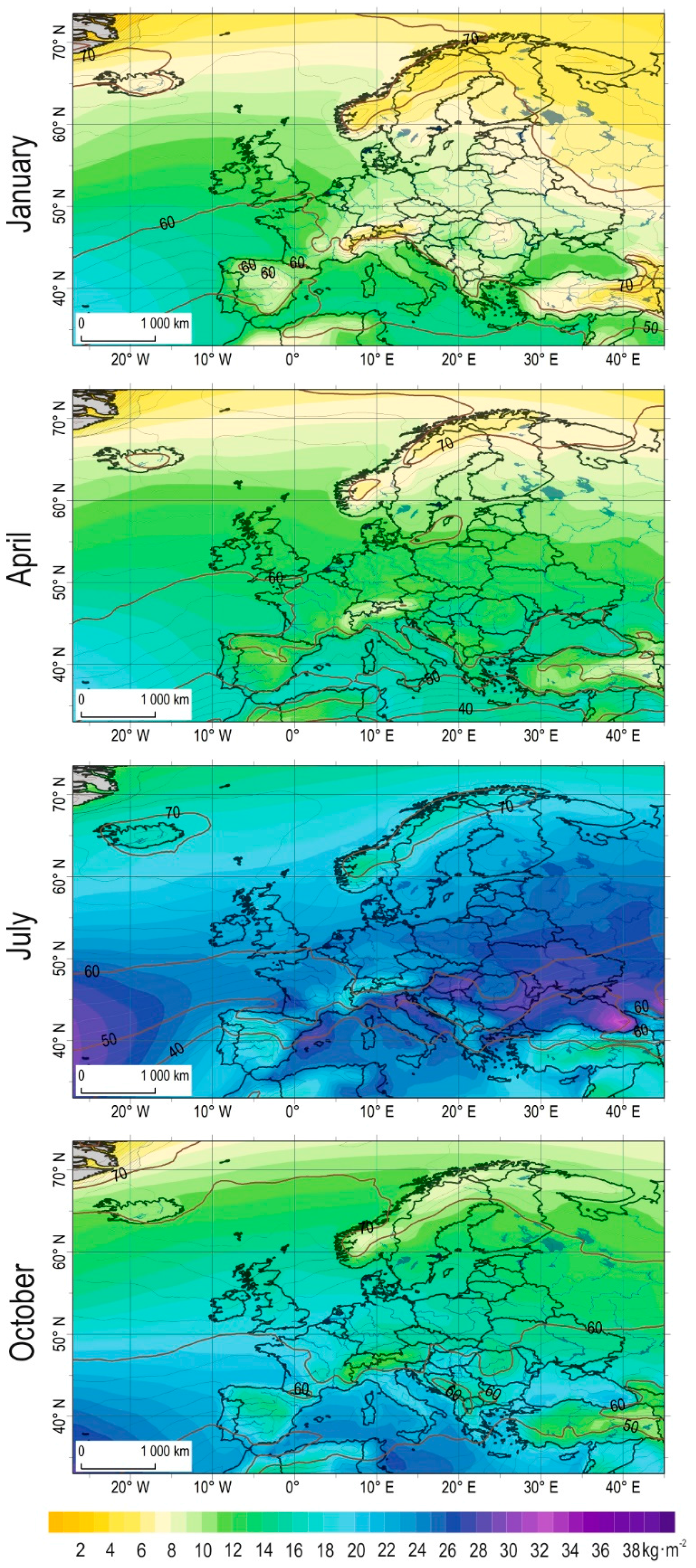
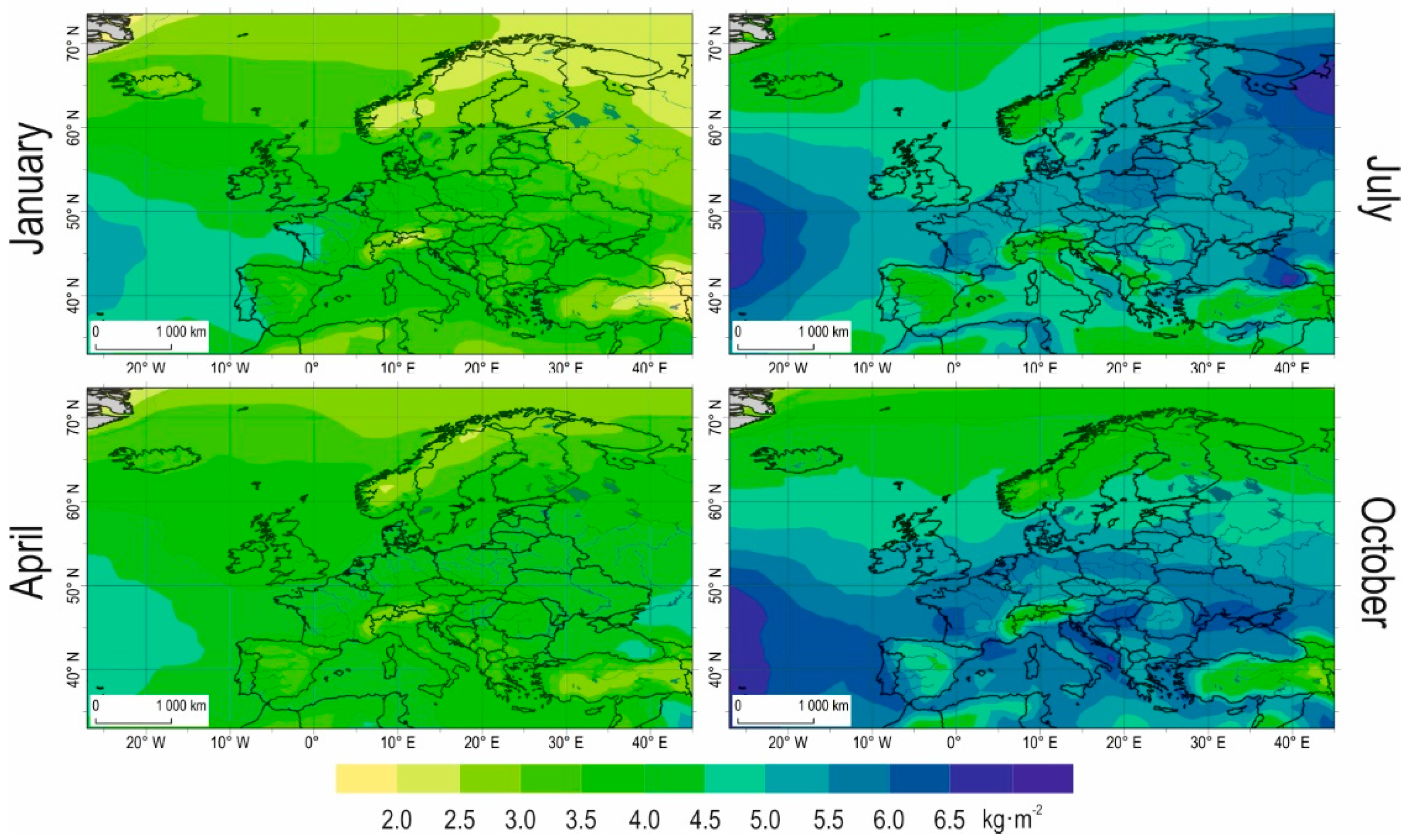
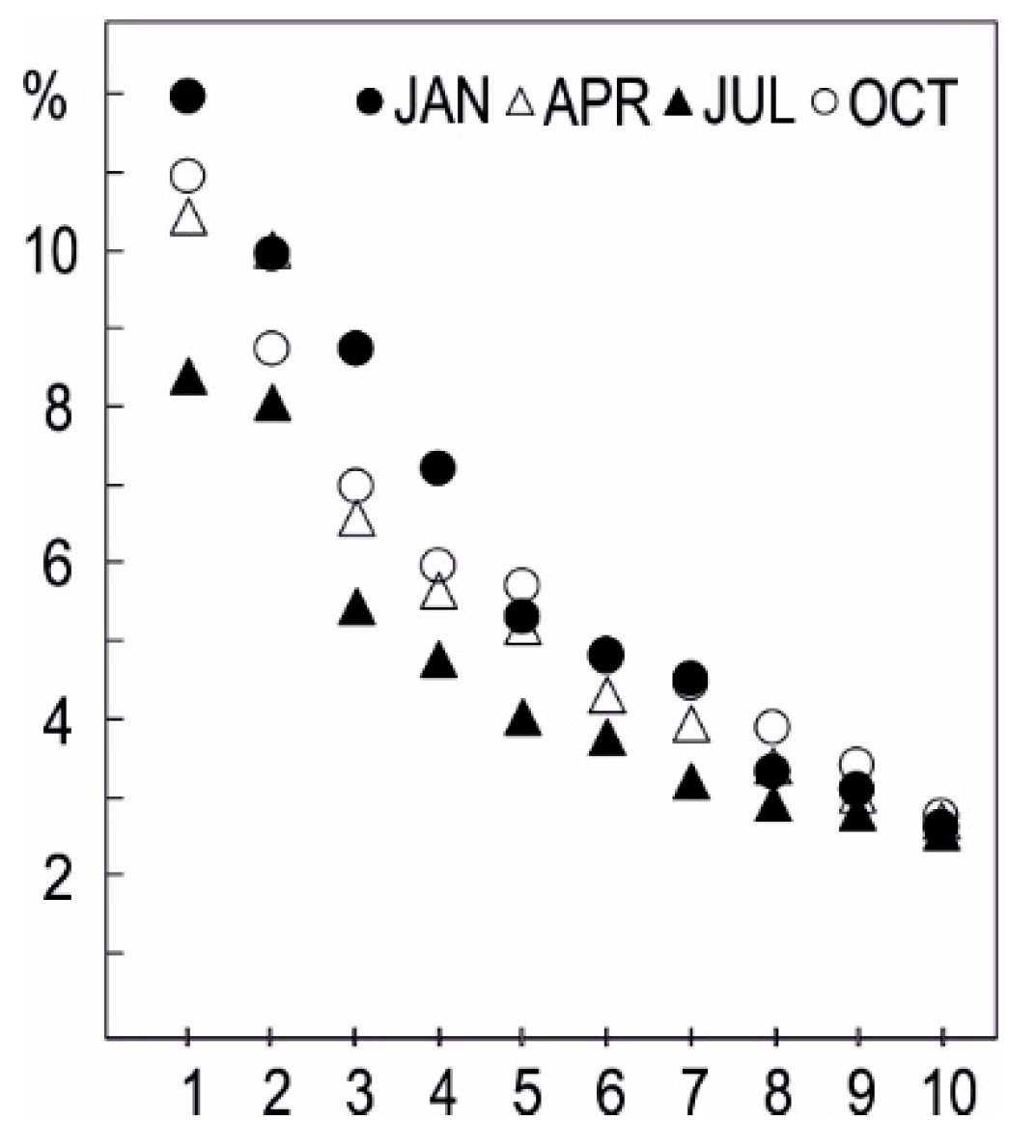
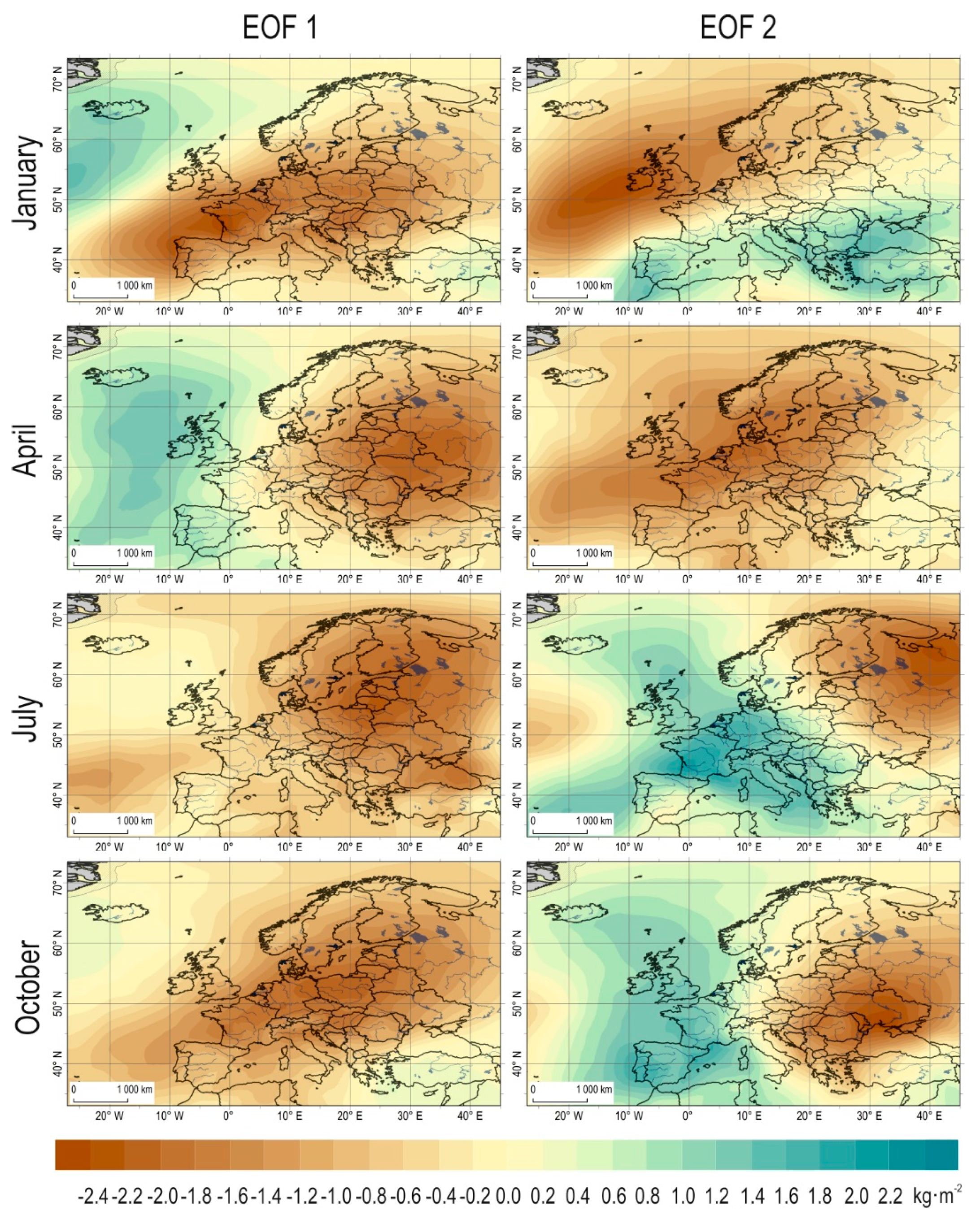


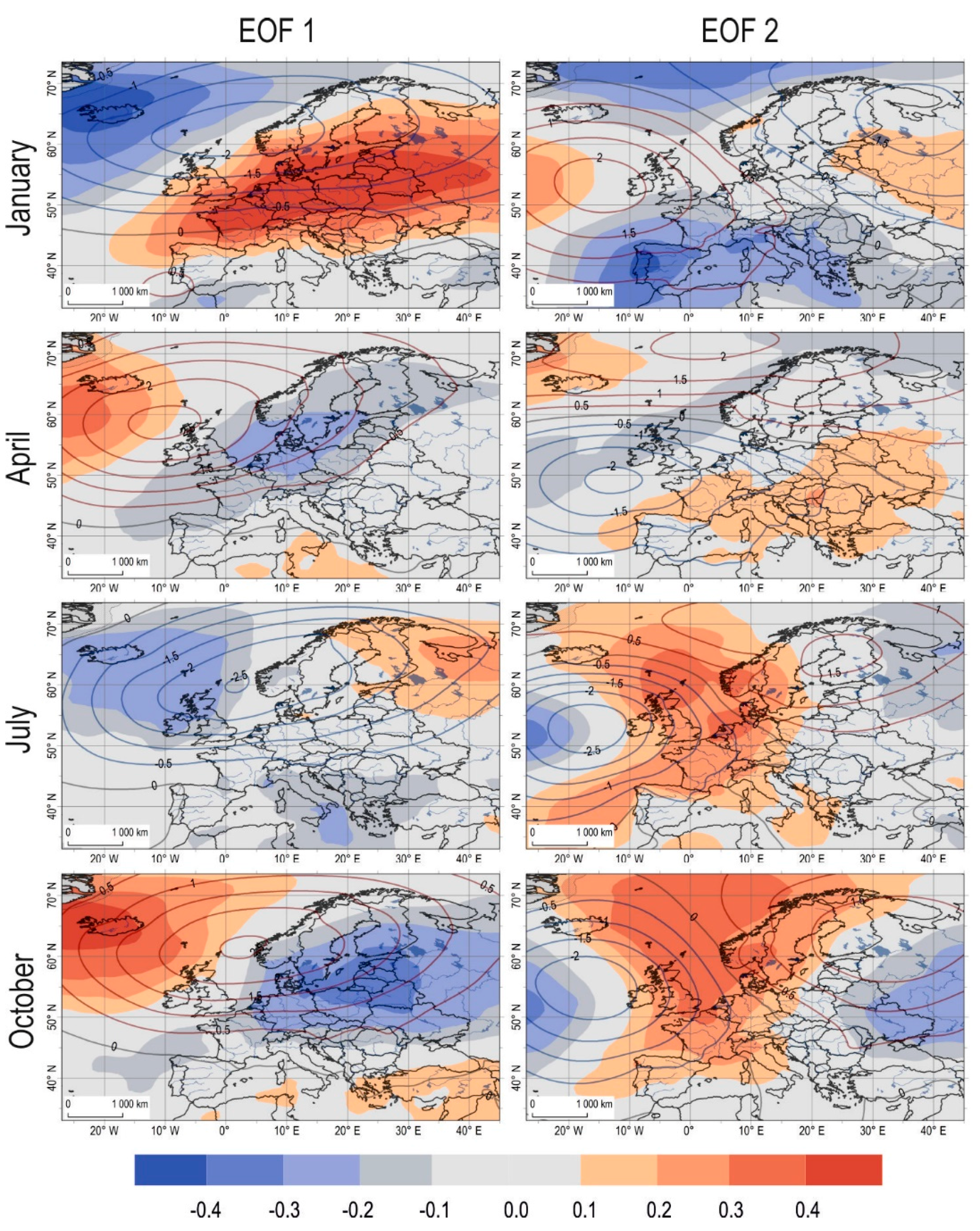


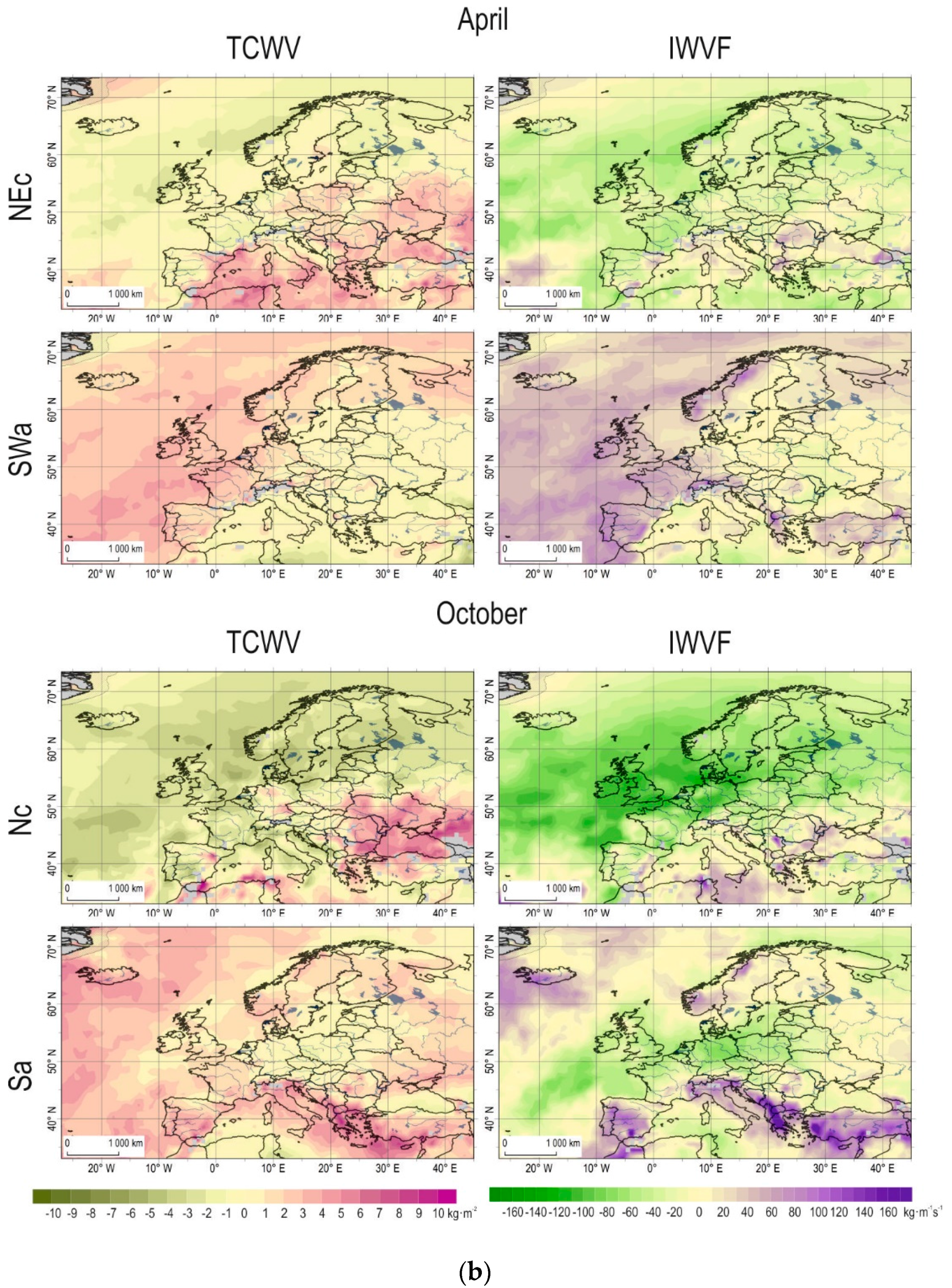
| Regions 1 | TCWV (kg·m−2) | RH (%) 7 | |||||||||||||
|---|---|---|---|---|---|---|---|---|---|---|---|---|---|---|---|
| DJF 2 | MAM | JJA | SON | Y 5 Ratio | S 6 Ratio | 950 | 850 | 700 | 500 | ||||||
| AV 3 | SD 4 | AV | SD | AV | SD | AV | SD | ||||||||
| 1 | NA | 6.6 | 2.8 | 7.8 | 3.3 | 14.8 | 4.4 | 10.3 | 4.3 | 2.64 | 0.76 | 6.1 | 8.8 | 6.4 | 8.6 |
| 2 | NC | 6.3 | 2.7 | 9.2 | 4.3 | 19.6 | 5.6 | 11.8 | 5.1 | 3.66 | 0.77 | 19.7 | 7.4 | 5.8 | 13.1 |
| 3 | MA | 11.5 | 4.1 | 13.1 | 4.4 | 20.7 | 5.3 | 16.5 | 5.6 | 2.01 | 0.79 | 7.0 | 5.3 | 6.0 | 7.9 |
| 4 | MC | 9.0 | 5.0 | 13.1 | 4.9 | 22.7 | 5.8 | 15.7 | 6.5 | 2.89 | 0.83 | 21.8 | 12.0 | 11.3 | 20.4 |
| 5 | SA | 16.9 | 3.9 | 17.5 | 4.6 | 25.0 | 4.9 | 23.2 | 6.1 | 1.72 | 0.75 | 7.0 | 12.8 | 8.4 | 13.7 |
| 6 | Med | 12.8 | 3.6 | 15.4 | 5.1 | 23.3 | 5.2 | 20.8 | 5.8 | 2.14 | 0.74 | 27.7 | 24.0 | 13.5 | 18.8 |
© 2018 by the authors. Licensee MDPI, Basel, Switzerland. This article is an open access article distributed under the terms and conditions of the Creative Commons Attribution (CC BY) license (http://creativecommons.org/licenses/by/4.0/).
Share and Cite
Wypych, A.; Bochenek, B.; Różycki, M. Atmospheric Moisture Content over Europe and the Northern Atlantic. Atmosphere 2018, 9, 18. https://doi.org/10.3390/atmos9010018
Wypych A, Bochenek B, Różycki M. Atmospheric Moisture Content over Europe and the Northern Atlantic. Atmosphere. 2018; 9(1):18. https://doi.org/10.3390/atmos9010018
Chicago/Turabian StyleWypych, Agnieszka, Bogdan Bochenek, and Michał Różycki. 2018. "Atmospheric Moisture Content over Europe and the Northern Atlantic" Atmosphere 9, no. 1: 18. https://doi.org/10.3390/atmos9010018





